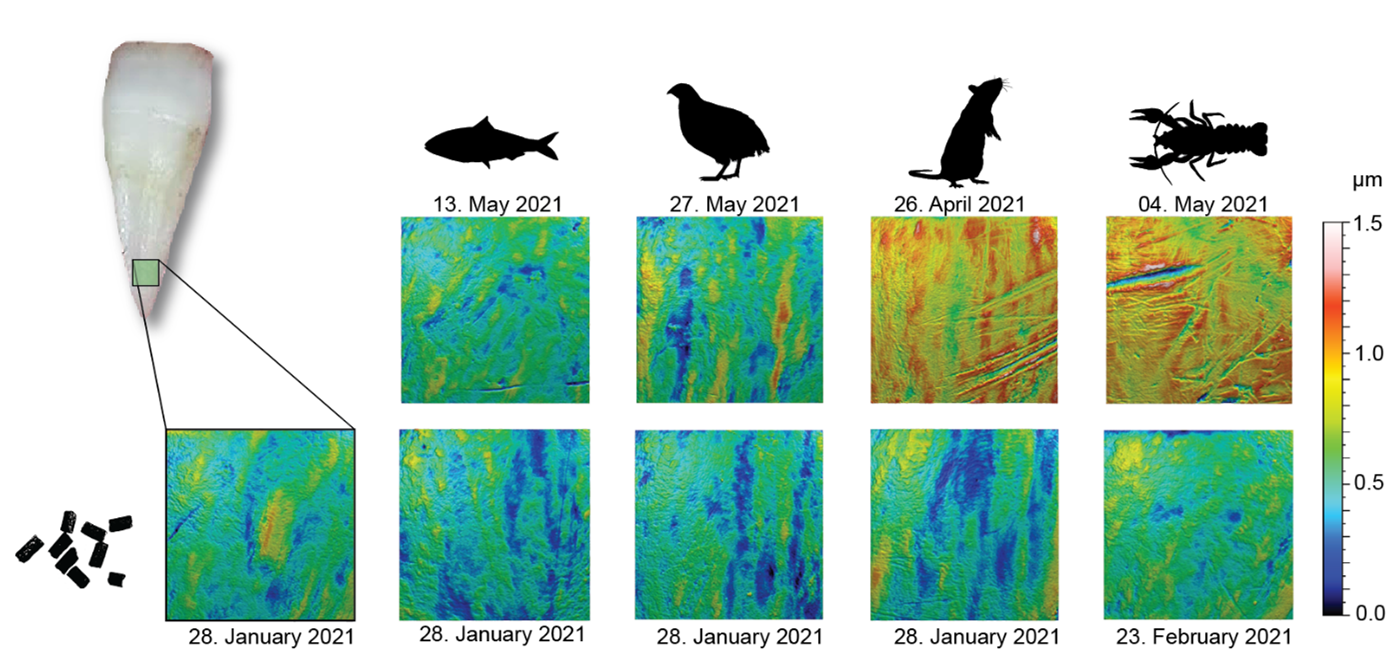2022-10-28 スイス連邦工科大学ローザンヌ校(EPFL)
開発した装置は、症状が現れる前の網膜色素上皮の変化を観察し、細胞を分化させることができる世界初の生体内画像を提供する。この早期発見能力により、臨床医は取り返しのつかない症状が出る前に、これらの疾患を診断することができるようになる。
研究チームは、白目に照射する2本の斜めビームと、光波の歪みを補正して鮮明な画像を生成する適応光学系を備えた網膜カメラを開発した。この技術は「経強膜光学イメージング」と呼ばれ、赤外線ビームを使用する点では既存の網膜イメージングシステムと同様である。
ビームは白目を通して斜めに焦点を結ぶので、瞳孔を介して網膜を照らしたときに、目の中心にある反射率の高い錐体視細胞によって引き起こされる過剰な光の問題を回避することができる。そして、光波は瞳孔から眼球を出るときにカメラに取り込まれる。
このカメラは、5秒以下の露光時間で100枚の生画像を撮影することができ、診断に使用する上で重要な速度的優位性を備えている。撮影した画像は、アルゴリズムによって整列・集約され、1枚の高画質画像として画面に表示される。インターフェースには、あらかじめ設定された眼の部位に対応する5つのボタンがあり、必要な画像を選択することができる。また、ユーザーは目の裏側の図のどこかをクリックして、撮りたい部分を正確に選択することができる。
<関連情報>
- https://actu.epfl.ch/news/a-new-device-for-early-diagnosis-of-degenerative-e/
- https://www.ophthalmologyscience.org/article/S2666-9145(22)00123-3/fulltext
生体内健常眼における経強膜光学イメージングを用いた網膜色素上皮イメージング。 in vivo Retinal Pigment Epithelium Imaging using Transscleral OPtical Imaging in healthy eyes
Laura Kowalczuk,Rémy Dornier,Mathieu Kunzi,Antonio Iskandar,Zuzana Misutkova,Aurélia Gryczka,Aurélie Navarro,Fanny Jeunet,Irmela Mantel,Francine Behar-Cohen,Timothé Laforest,Christophe Moser
Ophthalmology Science Published:October 18, 2022
DOI:https://doi.org/10.1016/j.xops.2022.100234

Abstract
Objective
To image healthy retinal pigment epithelial cells (RPE) in vivo using Transscleral OPtical Imaging (TOPI) and to analyze statistics of macular RPE cell features as a function of age, axial length (AL) and eccentricity.
Design
Single-center, exploratory, prospective, and descriptive clinical study.
Participants
49 eyes (AL: 24.03±0.93 mm; range: 21.88 – 26.7 mm) from 29 participants aged 21 to 70 years (37.1±13.3 years; 19 males, 10 females)
Methods
Retinal images, including ultra-wide field fundus photography and spectral-domain optical coherence tomography, AL and refractive error measurements were collected at baseline. For each eye, 6 high resolution RPE images were acquired using TOPI at different locations, one of them being imaged 5 times to evaluate the repeatability of the method. Follow-up ophthalmic examination was repeated 1 to 3 weeks after TOPI to assess safety. RPE images were analyzed with a custom automated software to extract cell parameters. Statistical analysis on the selected high-contrast images included calculation of coefficient of variation (CoV) for each feature at each repetition, Spearman and Mann-Whitney tests to investigate the relationship between cell features and eye and/or subject characteristics.
Main Outcome Measures.
RPE cell features such as density, area, center-to-center spacing, number of neighbors, circularity, elongation, solidity and border distance CoV.
Results
Macular RPE cell features were extracted from TOPI images at an eccentricity of 1.6° to 16.3° from the fovea. For each feature, the mean CoV was under 4%. Spearman’s test showed correlation within RPE cell features. In the perifovea, the region in which images were selected for all participants, longer AL significantly correlated with decreased RPE cell density (R Spearman, Rs=-0.746; p<0.0001) and increased cell area (Rs=0.668; p<0.0001), without morphological change. Aging also significantly correlated with decreased RPE density (Rs=-0.391; p=0.036) and increased cell area (Rs=0.454; p=0.013). Lower circular, less symmetric, more elongated and larger cells were observed over 50 years.
Conclusions
The TOPI technology imaged RPE cells in vivo with repeatability of less than 4% for the CoV and was used to analyze the influence of physiological factors on RPE cell morphometry in the perifovea of healthy volunteers.


